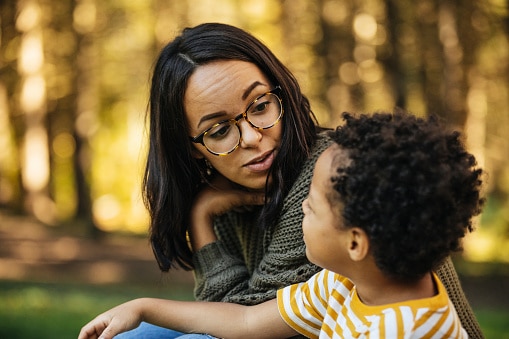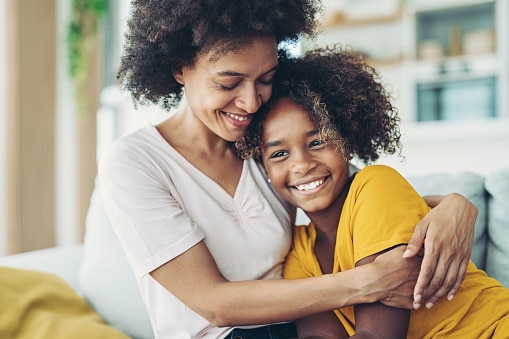It was a Fall Saturday in October in the PNW, and I was driving my youngest daughter to her soccer game. We got stuck on the bridge spanning Oregon and Washington. Due to an accident, traffic had come to a complete stop.
My daughter kept asking what time the GPS said we would arrive at her game and anxiously watched as the arrival time on the screen kept moving out while we were going nowhere fast. On all sides of us there was bumper-to-bumper traffic.
First came the tears, next the shallow breathing, and then the panic. Through tears and shallow breaths, my daughter started making statements like “This is the worst day ever” and “Why does this have to happen to me?” Then she escalated to blaming herself for letting her team down by not getting to the game on time.
The internal battle waged within me too. I echoed my daughter’s statements and struggled not to let them be the most real experience of the moment. I told myself to stay calm, but I wasn’t buying my own press.
What we meditate on occupies the space between our ears.

Supporting Anxious Kids
When we see anxiety grow in the bodies of the little ones we love and lead, it can feel helpless and cause our own anxiety to rise to the surface. In our efforts to help provide tools and resources for the children in our care, we must stay calm and regulate ourselves.
We were in a situation where we could not control the outcome, yet there were certain things still within our control.
Choosing to be present for my daughter and provide her with guidance and resources was what this minor crisis called for. I knew how to be present with my daughter in her anxiety and how to help her move through it. The soccer game had quickly taken a backseat.
The most important truth to communicate was that my daughter’s performance (in the game and life) was not more important (and never would be) than her peace.
Anxiety is a common mental health condition that affects people of all ages, including children.
According to the National Institute of Mental Health, anxiety disorders are the most common mental health disorder in the United States, affecting 31.9% of adults at some point in their lives. Anxiety in children has been on the rise over the past few years, with studies indicating that up to 25% of elementary school students suffer from some form of anxiety.
How we respond to a child’s anxiety will make a big difference in how they learn to cope with anxious feelings.
The best way to help children overcome anxiety is to teach them to deal with anxiety as it comes up. With practice, they will be less anxious. When anxiety rises in the children we love and lead, consider using these practices to help them find their way back to peace.
Supporting Anxious Kids: Validate Their Feelings
When children are validated, they experience a reduction in the intensity of their emotions. Reducing the intensity of the emotion allows them to move through the meltdown faster, opening the child up to problem-solving or pushing through a challenging situation or task.
The best way to help children overcome anxiety is to teach them to deal with anxiety as it comes up.
Teach Deep Breathing
Research reveals that slow, deep breathing can help mitigate symptoms of depression and anxiety. If your child experiences physical symptoms of anxiety, like a racing heartbeat or tight muscles, teaching them how to calm their body using simple breathing exercises is a helpful and accessible tool.
Try using this quick and easy way to help children get their breathing under control. It is a technique called “smell the pizza.” Use this easy explanation to share with children:
- Imagine a slice of pizza. You can replace “pizza” with other hot food, such as a cookie or soup.
- Smell the pizza. Take a deep breath through your nose to inhale the delicious scent.
- Cool the pizza. Pretend you’re cooling the pizza by slowly blowing air out of your mouth.
Exercise: Movement Matters
Exercise is an effective way to reduce anxiety in children. It helps to release endorphins, which are natural mood boosters. Exercise also helps reduce the physical symptoms of anxiety, such as muscle tension, rapid heartbeat, and shallow breathing.
Meditate on What Is True, Using Scripture as a Guide
What we meditate on occupies the space between our ears. This is true for all humans—adults and children alike. Lead your children to the source of truth in the Scriptures and guide them in meditating and thinking on true statements that provide peace and hope.
Here are a few Scripture passages to reference when supporting anxious kids in your care.
“Peace I leave with you; my peace I give you. I do not give to you as the world gives. Do not let your hearts be troubled and do not be afraid.”
John 14:27
“Cast all your anxiety on him because he cares for you.”
1 Peter 5:7

Seek Professional Help
Although we have tools and strategies to help the children in our care move through their anxiety, sometimes they need more than we can offer them. Depending on our role, we should seek wise counsel from a senior staff member.
If you are the legal guardian of a child struggling with anxiety, it may be best to consult a pediatrician and connect with mental health providers working with children and adolescents. This is especially true if your child’s anxiety lasts more than a few weeks or if your child’s anxiety interferes with everyday functioning.
In children, anxiety disorders are common. Over 4 million children in the U.S. (approximately 7%) ages 3-17 experience issues with anxiety each year.
As parents, coaches, teachers, and leaders, what we can do is offer support and presence to children as they move safely through their anxiety.
. . .
We didn’t end up spending that whole Fall Saturday stuck on the bridge between Oregon and Washington. In time, the cars started to move again, and we made it to the game. We were late, and my daughter missed the start of an important game.
To move through the anxiety she was experiencing, we put into practice a few of the strategies mentioned above.
It took some more time sitting in the school’s parking lot before my daughter was calm and regulated enough to join her team. Sometimes the only way is through. We can’t know how each anxiety episode will resolve because we can’t know or predict the future. As parents, coaches, teachers, and leaders, what we can do is offer support and presence to children as they move safely through their anxiety.
Read More in this Helpful Series on Supporting Anxious Kids: Practical Ways to Navigate A Hyper-Anxious World
- Introduction (Part 1)
- What Causes Anxiety (Part 2)
- A Matter of the Brain (Part 3)
- Tools to Help (Part 4)
- Restoring Power (Part 5)
- Conclusion (Part 6)










